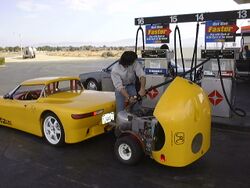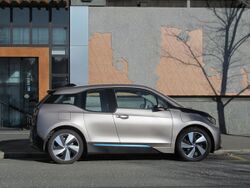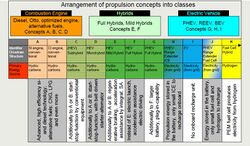Engineering:Range extender

A range extender is a fuel-based auxiliary power unit (APU) that extends the range of a battery electric vehicle by driving an electric generator that charges the vehicle's battery. This arrangement is known as a series hybrid drivetrain. The most commonly used range extenders are internal combustion engines, but fuel-cells or other engine types can be used.[1]
Range extender vehicles are also referred to as extended-range electric vehicles (EREV), range-extended electric vehicles (REEV), and range-extended battery-electric vehicle (BEVx) by the California Air Resources Board (CARB).[2]
Many range extender vehicles, including the Chevrolet Volt and the BMW i3, are able to charge their batteries from the grid as well as from the range extender, and therefore are a type of plug-in hybrid electric vehicle (PHEV).[3][4]
Motivation
The key function of the range extender is to increase the vehicle's range. Range autonomy is one of the main barriers for the commercial success of electric vehicles, and extending the vehicle's range when the battery is depleted helps alleviate range anxiety.[5]
A range extending vehicle design can also reduce the consumption of the range extending fuel (such as gasoline) by using the primary fuel (such as battery power), while still maintaining the driving range of a single fuel vehicle powered by a range extending fuel such as gasoline. The range extending fuel is generally considered to be less environmentally and economically friendly to use than the primary fuel source, so the vehicle control system gives preference to using the primary fuel if it's available. However, due to range limitations with the primary fuel source, the range extending fuel allows the vehicle to get many of the cost and environmental benefits of the primary fuel, while maintaining the full driving range of the range extending fuel source.[6] That said, the benefits (cost, carbon emissions) derived from using a vehicle with a range extender ultimately depend on how the vehicle is driven, and in particular how often the range extender is used.[7]
As an example, cars such as the Chevrolet Volt and the BMW i3 with optional range extender are equipped with sufficiently large batteries to drive 80–160 km (50–100 miles), which is enough for many trips but not sufficient to drive long distances. As such, the driver may use battery power for commuting and daily driving, but still be able to drive from New York City to Boston (about 320 km, 200 miles) by using the auxiliary gasoline internal combustion engine, without stopping frequently to charge the battery (which can take hours). The vehicle owner therefore accrues the benefits of using cheaper and less carbon-intensive electric power for most driving, while maintaining the ability to embark on longer trips with the same vehicle.
When a range extender uses conventional fuels they can re-fuel at regular fuel stations, which provides them with a similar driving range to conventional automobiles.[8][9][10]
As an REEV is only propelled by the electric motor it can do away with the weight and cost associated with the gearbox transmission system typically used in internal combustion engine cars. Further, as the range extender does not need to increase or decrease output in line with the power needs of the vehicle (this task is handled by the electric motor) the range extender can be sized to satisfy the vehicle's average power requirement rather than its peak power requirement (such as when accelerating). The range extender can also operate much closer to its most efficient rotational speed. These design features allow an REEV to convert fossil fuel energy to electric power and vehicle motion relatively efficiently.
Generations
- The first generation range extenders are off the shelf internal combustion engines.
- The second generation consists of piston engines with new designs from scratch for fairly constant load in series hybrids. They include the wankel engines, rotary combustion engines and free piston engines.
- The third generation are micro turbines and fuel cells that work at constant load.[11]
CARB regulation
According to 2012 Amendments to the Zero Emission Vehicle Regulations adopted in March 2012 by the California Air Resources Board (CARB), a range-extended battery-electric vehicle, designated as BEVx, should comply, among others, with the following criteria:[2]
- The vehicle must have a rated all-electric range of at least 120 km (75 miles). This is higher than the 80 km (50 miles) required of a zero-emission vehicle;
- The auxiliary power unit (APU) must provide range less than or equal to battery range;
- The APU must not be capable of switching on until the battery charge has been depleted;
- The vehicle must meet super ultra low emission vehicle (SULEV) requirements; and
- The APU and all associated fuel systems must comply with zero evaporative emissions requirements.
Applications
Range extenders are commonly used in marine (autonomous underwater vehicle), aircraft and Generator/Utility, automotive[12] and hybrid electric vehicle applications.[13]
Automotive
Chevrolet Volt
General Motors describes the Chevrolet Volt as an electric vehicle equipped with a 16 kWh battery plus a "range extending" gasoline powered internal combustion engine (ICE) as a genset and therefore dubbed the Volt an "Extended Range Electric Vehicle" or E-REV.[3][4][14] In a January 2011 interview, the Chevy Volt's Global Chief Engineer, Pamela Fletcher, referred to the Volt as "an electric car with extended range."[15] The Volt operates as a purely electric car for the first 40–80 km (25–50 miles) in charge-depleting mode. When the battery capacity drops below a pre-established threshold from full charge, the vehicle enters charge-sustaining mode, and the Volt's control system will select the most optimally efficient drive mode to improve performance and boost high-speed efficiency.[3][16][17]
According to General Motors' real time tally of the distance driven by Volt owners in North America, by mid June 2014 they had accumulated more than 800 million all-electric km (500 million miles). GM also reported that Volt owners driving is more than 63% in all-electric mode. Volt owners who charge regularly typically drive more than 1,560 km (970 miles) between fill-ups and visit the gasoline station less than once a month.[18] A similar report, issued by GM in August 2016, reported that Volt owners have accumulated almost 2.4 billion km (1.5 billion miles) driven in EV mode, representing 60% of their total distance traveled.[19]
BMW i3
The BMW i3 all-electric car with at least 22 kWh battery capacity offers an optional gasoline-powered range extender APU.[20] The range extender is the same 647 cc two-cylinder gasoline engine used in the BMW C650 GT scooter with a 9 L (2.0 imp gal; 2.4 US gal) fuel tank. The US model originally had its tank electronically limited to a smaller 7 L capacity.[21] The range extender engages when the battery level drops to 6%. It generates electricity to extend the range from 130–160 km (80–100 miles) to 240–300 km (150–190 miles)[22][23] Performance in range-extending mode may be more limited than when it is running on battery power, as BMW designed the range extender as a backup to enable reaching a recharging location.[24]
According to BMW, at the beginning of the i3 release, the use of range-extender was much more than the carmaker expected, more than 60%. Over time it has decreased significantly, with some people almost never using it, and by 2016 it is being regularly used in fewer than 5% of i3s.[25]
The range-extender option costs an additional US$3,850 in the United States,[26] an additional €4,710 (~ US$6,300) in France,[27] and €4,490 (~ US$6,000) in the Netherlands.[28]
The range-extender option of the BMW i3 was designed to meet the CARB regulation for an auxiliary power unit (APU) called REx. According to rules CARB adopted in March 2012, the 2014 BMW i3 with a REx unit fitted will be the first car to qualify as a range-extended battery-electric vehicle or "BEVx." CARB describes this type of electric vehicle as "a relatively high-electric range battery-electric vehicle (BEV) to which an APU is added." The APU, which maintains battery charge at about 6% after the pack has been depleted in normal use, is strictly limited in the additional range it can provide.[2][29]
Other examples
Other range-extended electric vehicles include the discontinued Cadillac ELR and the discontinued Fisker Karma.[30][31][32] In June 2016, Nissan announced it will introduce a compact range extender car in Japan before March 2017. The series plug-in hybrid will use a new hybrid system, dubbed e-Power, which debuted with the Nissan Gripz concept crossover showcased at the 2015 Frankfurt Auto Show.[33] The technology, without the plug-in ability, had been deployed to the Nissan Note e-Power and Nissan Kicks e-Power.
The LEVC TX London taxi was launched in 2017 and features a 33 kWh battery that is charged by a 1.5-litre gasoline engine.[34]
The Lixiang One is a large SUV which combines a 41-kWh battery with a small 1.2-litre gasoline engine.[35][36]
This approach has also been used for heavy vehicles, such as Wrightbus's Gemini 2[37] and New Routemaster[38] buses.
Hydrogen fuel cells have also been used as a range extender for battery electric buses, allowing them to have greater range.[39] For example, the Mercedes-Benz eCitaro has a range of 280 kilometres (170 mi) as a battery electric model, with the eCitaro fuel cell bus having a range of 400 kilometres (250 mi) thanks to a 60kW Toyota fuel cell that recharges the battery.[40]
Ford has patents for a bed mounted gasoline-powered generator for their fully electric pickups.[41] Rivian has patents for bed mounted additional batteries for increased range.[42] Rivian electric trucks can charge each other for extended range.[43]
Unmanned aerial vehicles
The 2010 Wolverine 3 program included an ICE range extender for its unmanned aerial vehicle.[44]
Powertrain
A range-extended electric vehicle uses a series hybrid drivetrain.
See also
References
- ↑ Harrop, Peter (2015-03-13). "Hybrid vehicle range extenders: goodbye pistons". IDTechEx. http://www.idtechex.com/research/articles/hybrid-vehicle-range-extenders-goodbye-pistons-00007552.asp?donotredirect=true.
- ↑ Jump up to: 2.0 2.1 2.2 John Voelcker (2013-10-23). "2014 BMW i3 Electric Car: Why California Set Range Requirements, Engine Limits". Green Car Reports. http://www.greencarreports.com/news/1087888_2014-bmw-i3-electric-car-why-california-set-range-requirements-engine-limits.
- ↑ Jump up to: 3.0 3.1 3.2 Matthe, Roland; Eberle, Ulrich (2014-01-01). "The Voltec System – Energy Storage and Electric Propulsion". https://www.researchgate.net/publication/262004450.
- ↑ Jump up to: 4.0 4.1 "Chevrolet Volt Hits Road, Ahead of Schedule". The New York Times. 2009-06-25. http://wheels.blogs.nytimes.com/2009/06/25/chevrolet-volt-hits-road-ahead-of-schedule/.
- ↑ Vortisch, Peter; Chlond, Bastian; Weiß, Christine; Mallig, Nicolai (June 2015). "Electric Vehicles with Range Extender as a Suitable Technology (EVREST)". Karlsruher Institut für Technologie. http://www.ifv.kit.edu/english/26_EVREST.php.
- ↑ Bradley, Thomas; Frank, Andrew. "Design, demonstrations and sustainability impact assessments for plug-in hybrid electric vehicles". http://www.engr.colostate.edu/~thb/Publications/Design%20Development%20and%20Sustainability%20impacts%20assessments%20for%20PHEVs_FINAL.pdf.
- ↑ Bradley, Thomas; Quinn, Casey. "Analysis of plug-in hybrid electric vehicle utility factors". http://www.engr.colostate.edu/~thb/Publications/Bradley%20and%20Quinn%20Analysis%20of%20Plug%20in%20Hybrid%20Electric%20Vehicle%20Utility%20Factors.pdf.
- ↑ Michael Graham Richard (2009-10-14). "Could Range Anxiety Sabotage the Promise of Electric Cars?". Discovery's Planet Green. http://auto.howstuffworks.com/range-anxiety-electric-cars1.htm.
- ↑ "Plug-In Hybrid Electric Vehicle (PHEV)". Center for Energy and the Global Environment, Virginia Tech. http://www.ceage.vt.edu/phev.
- ↑ "What Is A Plug-in Hybrid Car?". HybridCars.com. http://www.hybridcars.com/plug-in-hybrid-cars.
- ↑ Range Extenders for Electric Vehicles Land, Water & Air 2013-2023. 2013-07-08. http://www.idtechex.com/en/research-report/range-extenders-for-electric-vehicles-land-water-and-air-2013-2023/357.
- ↑ "Electric vehicle and range extender". http://www.klimafonds.gv.at/assets/Uploads/2AVL-Beste.pdf.
- ↑ "Multiple Use Engine Including marine, military, automobile, light aircraft". http://www.dukeengines.com/application/range-ext/.
- ↑ Jonathan Oosting (2010-10-12). "Is the Chevrolet Volt a true electric car? General Motors defends EV label". MLive.com. http://www.mlive.com/auto/index.ssf/2010/10/is_the_chevrolet_volt_a_true_e.html.
- ↑ Kuchment, Anna (January 2011). "Practically Green: A Q&A with the Chevy Volt's Chief Engineer". Scientific American (Nature America) 304 (1): p. 25. ISSN 0036-8733. http://www.scientificamerican.com/article.cfm?id=practically-green.
- ↑ Norman Mayersohn (2010-10-15). "Sorting Myth From Fact as Volt Makes Its Debut". New York Times. https://www.nytimes.com/2010/10/17/automobiles/17VOLT.html?_r=1&scp=1&sq=Chevy%20Volt&st=cse.
- ↑ Frank Markus (2010-10-10). "Unbolting the Chevy Volt to See How it Ticks". Motor Trend. http://www.motortrend.com/features/editorial/1010_unbolting_the_chevy_volt_to_see_how_it_ticks/index.html.
- ↑ "Chevrolet Volt Owners Surpass Half a Billion Electric Miles" (Press release). US: General Motors. 2014-06-17. Retrieved 2014-07-02.
- ↑ Cobb, Jeff (2016-08-01). "100,000th Chevy Volt Sold in US". HybridCars.com. http://www.hybridcars.com/100000th-chevy-volt-sold-in-us/.
- ↑ Viknesh Vijayenthiran (2010-07-20). "First Major Outing For BMW Megacity Vehicle At 2012 London Olympic Games". Motor Authority. http://www.motorauthority.com/blog/1047387_first-major-outing-for-bmw-megacity-vehicle-at-2012-london-olympic-games.
- ↑ John O'Dell. "BMW i3 Range Boost: Up 40% for 2017". https://thegreencarguy.com/bmw-i3-ev-gets-range-boost-2017/.
- ↑ Jay Cole (2013-07-29). "BMW i3 Range Extender To Offer Up to 87 More Miles, Decreases Performance". http://insideevs.com/bmw-i3-range-extender-to-offer-up-to-87-more-miles-decreases-performance/.
- ↑ Greg Kable (2013-02-24). "First rides in BMW i8 hybrid sportscar and all-electric i3". Autocar. http://www.autocar.co.uk/car-news/new-cars/first-rides-bmw-i8-hybrid-sportscar-and-all-electric-i3.
- ↑ John Voelcker (2013-03-12). "BMW i3 Electric Car: ReX Range Extender Not For Daily Use?". Green Car Reports. http://www.greencarreports.com/news/1082814_bmw-i3-electric-car-rex-range-extender-not-for-daily-use/page-2.
- ↑ Duff, Mike (2016-03-08). "BMW i Chief: Larger i Models Will Offer Optional Range-Extender". Car and Driver. http://blog.caranddriver.com/bmw-i-chief-i5-ev-model-coming-will-offer-optional-range-extender.
- ↑ Benjamin Preston (2013-07-29). "BMW Unveils i3 Electric Car". The New York Times. http://wheels.blogs.nytimes.com/2013/07/29/bmw-unveils-i3-electric-car/?ref=automobiles&_r=1&.
- ↑ Michaël Torregrossa (2013-07-30). "Voiture électrique – La BMW i3 officiellement révélée" (in fr). Association pour l'Avenir du Véhicule Electrique Méditerranéen (AVEM). http://www.avem.fr/actualite-voiture-electrique-la-bmw-i3-officiellement-revelee-4303.html.
- ↑ Eric Loveday (2013-07-22). "Official: BMW i3 Range Extender Option Adds 4,490 Euros ($5,919 US) to Price Tag in Netherlands". InsideEVs.com. http://insideevs.com/official-bmw-i3-range-extender-option-adds-4490-euros-5919-us-to-price-tag-in-netherlands/.
- ↑ Tom Moloughney (2014-10-24). "The i3 REx: One Owners Thoughts on the BEVx Restrictions". BMWBlog. http://www.bmwblog.com/2014/10/24/i3-rex-one-owners-thoughts-bevx-restrictions/.
- ↑ Eric Loveday (2013-02-06). "Frost & Sullivan Predicts Boom in Extended-Range Electric Vehicles". PluginCars.com. http://www.plugincars.com/frost-sullivan-predicts-boom-sales-extended-range-electric-vehicles-2018-126357.html.
- ↑ Sam Abuelsamid (2009-04-02). "What is a series hybrid/extended range electric vehicle?". Autoblog Green. http://green.autoblog.com/2009/04/02/greenlings-what-is-a-series-hybrid-extended-range-electric-vehi/.
- ↑ John Voelcker (2012-03-13). "2012 Fisker Karma -Review". Green Car Reports. http://www.greencarreports.com/overview/fisker_karma_2012.
- ↑ Greimel, Hans (2016-06-25). "Nissan's to-do list: Range, autonomy". Automotive News. http://www.autonews.com/article/20160625/OEM05/306279981/nissans-to-do-list-range-autonomy.
- ↑ Moldrich, Curtis (2018-04-04). "LEVC TX review: London's new electric taxi driven". Car Magazine. UK. https://www.carmagazine.co.uk/car-reviews/levc/levc-tx-review-londons-new-electric-black-taxi-cab-driven/.
- ↑ "Li Xiang Launches With "One" SUV With Six Seats, Four Screens, Hybrid Powertrain". 2019-03-21. https://www.carscoops.com/2019/03/li-xiangs-first-model-has-six-seats-four-screens-and-a-hybrid-powertrain/.
- ↑ "理想汽车 | 创造移动的家, 创造幸福的家" (in Chinese). China. https://www.lixiang.com/mall/one.html.
- ↑ Navarro, Xavier (2009-05-14). "A hybrid bus that cuts fuel consumption in half". Autoblog. http://www.autoblog.com/2009/05/14/a-hybrid-bus-that-cuts-fuel-consumption-in-half/.
- ↑ "New Routemaster technical specifications". http://www.wrightsgroup.com/datasheets/Routemaster%20spec%20sheet.pdf.
- ↑ "Hamburg to test the eCitaro with fuel cell range extender in 2021" (in en-US). 2019-09-05. https://www.sustainable-bus.com/fuel-cell-bus/hamburg-to-test-the-ecitaro-with-fuel-cell-range-extender-in-2021/.
- ↑ "Drum roll for Mercedes eCitaro with FC range extender" (in en-US). 23 May 2023. https://www.electrive.com/2023/05/23/drum-roll-for-mercedes-ecitaro-with-fc-range-extender/.
- ↑ "Ford F-150 Electric Patent Shows Range-Extending Gas Generator" (in en). https://www.motor1.com/news/446705/ford-f150-electric-patent-images/.
- ↑ Stumpf, Rob (11 November 2020). "Rivian Patents Removable Bed-Mounted Battery Pack for Extended Range" (in en). https://www.thedrive.com/news/37583/new-rivian-patent-confirms-removable-bed-mounted-battery-pack-for-extended-range.
- ↑ "Rivian's electric trucks can charge each other" (in en-US). https://www.engadget.com/2019-06-09-rivian-electric-vehicles-can-charge-each-other.html.
- ↑ Brooke, Lindsay (2010-06-21). "Secrets of Ricardo's new UAV engine may spawn range-extender for EVs". Society of Automotive Engineers International. http://articles.sae.org/8424/.
 |





